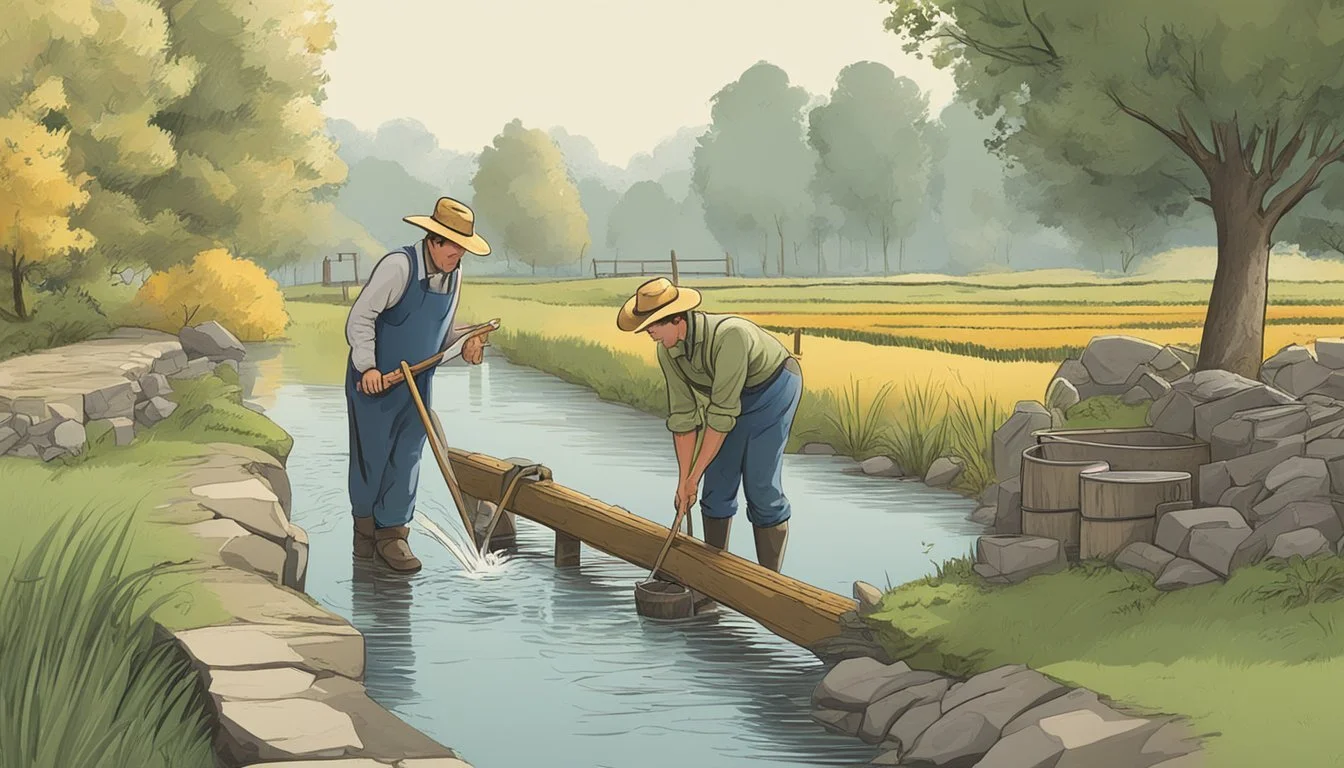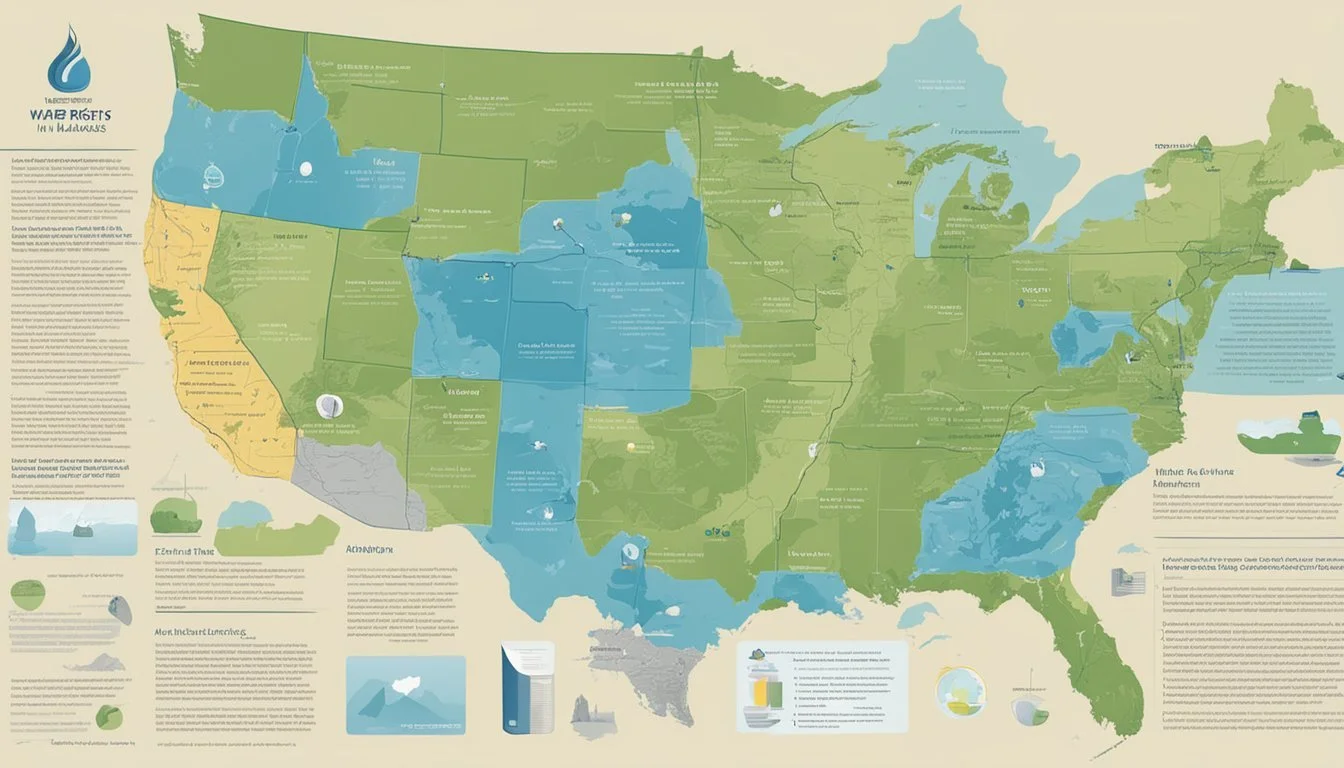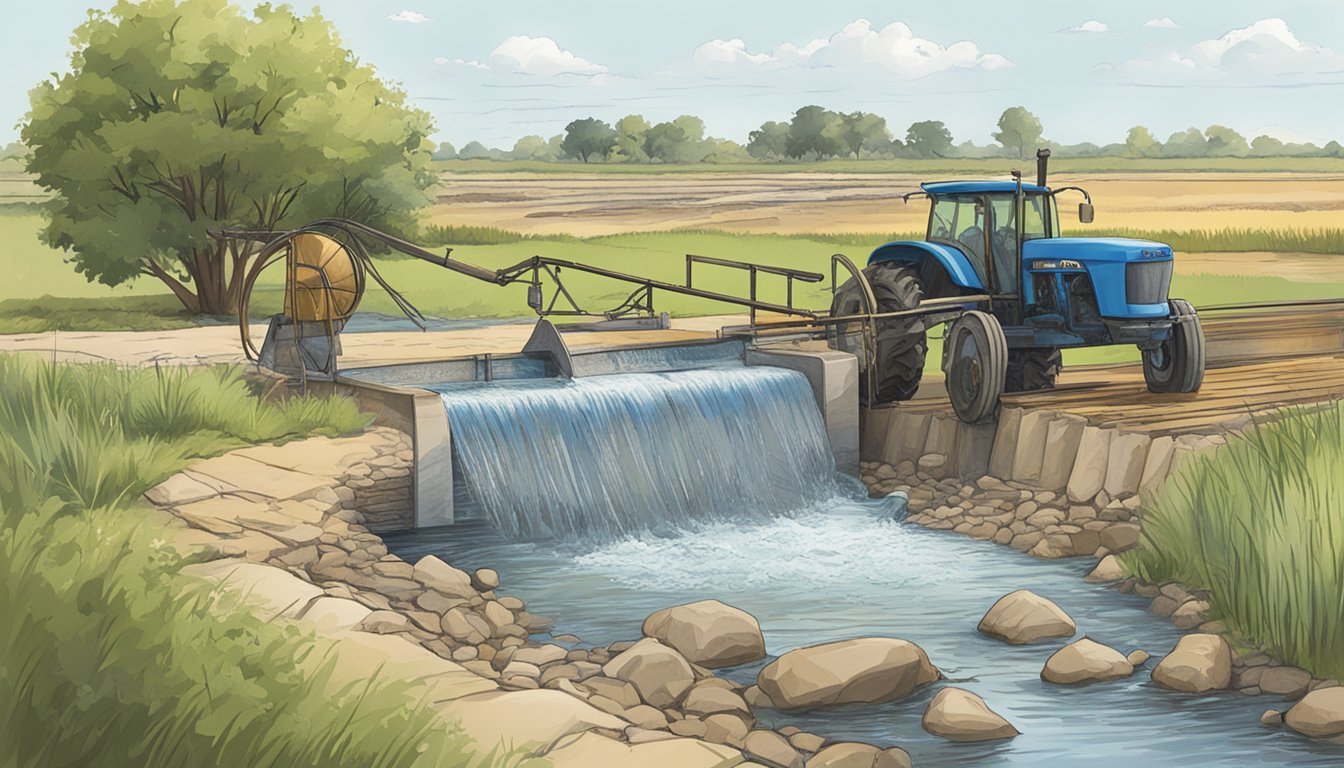Water Rights in Kansas
Navigating Legal and Environmental Challenges
Water rights in Kansas are a critical aspect of the state's agricultural and economic framework, ensuring that the allocation of water resources is managed effectively. The foundational principle governing the use of water in Kansas is captured by the doctrine of "first in time, first in right," where water rights are prioritized based on their historical establishment. This approach becomes particularly important during periods of scarcity, where those holding the earliest rights have the precedence to utilize water sources over those with more recent claims.
The administration of water rights is overseen by the Kansas Department of Agriculture through the Water Appropriation Act, which outlines the regulations for the management of the state's water resources. This legislative framework is essential for the fair apportionment of water, especially given that water rights are considered a form of property right within the state. Kansas water law is also intricately connected with federal law; even so, it is primarily dictated by state legislation, with federal law taking supremacy only under certain constitutional conditions.
Navigating the complexities of water law entails understanding not only the legislation but also how water rights are recorded, transferred, and modified. Kansas has established systems for maintaining detailed records of water right and permit details, ensuring accuracy in the allocation process. This meticulous record-keeping facilitates transparency and fairness in the distribution of one of the state's most vital natural resources.
Historical Context of Water Rights in Kansas
The evolution of water rights in Kansas is shaped by legislative actions and geological assessments, which have led to the development of the Kansas Water Appropriation Act and the involvement of the Kansas Geological Survey.
Development of the Kansas Water Appropriation Act
In Kansas, the waters have been regulated under a doctrine that combines aspects of both riparian and prior appropriation systems. The pivotal legislation, known as the Kansas Water Appropriation Act of 1945, established the framework for regulating water use and rights in the state. This Act implemented the doctrine of "first in time, first in right," prioritizing water rights based on the chronology of established uses.
Role of the Kansas Geological Survey
The Kansas Geological Survey plays a crucial role in the state's water rights through its comprehensive assessments of water resources. They provide critical data on groundwater supplies which inform the state's decisions on water allocations. Their research supports the equitable distribution of water and aids in the defense of Kansas's water claims in interstate water compacts.
Understanding Water Rights
Water rights in Kansas adhere to a doctrine that links ownership tightly with the concept of beneficial use. These rights are a pivotal component of state policy and dictate water resource management.
Defining a Water Right
In Kansas, a water right is a legal entitlement that authorizes the holder to use a specific amount of water from a defined source for a defined purpose. According to the Kansas Department of Agriculture, the principle of "first in time, first in right" guides this allocation, meaning priority is given to older rights in times of scarcity. Documentation and management of these rights are essential for fair distribution among users.
Beneficial Use and Rights Allocation
Beneficial use is the cornerstone of water rights in Kansas; merely owning land adjacent to water does not confer a right to use that water. A water right is established for a beneficial purpose, such as agriculture, domestic, or industrial use. The Kansas Water Appropriation Act emphasizes that all rights must serve a beneficial use to be considered valid. The state's water rights policy ensures that allocations support efficient usage and contribute to the overall public interest while respecting senior rights.
Regulation and Management
In Kansas, water rights and usage are strictly governed to ensure the equitable distribution and preservation of this vital resource. The state has established a robust legal framework and designated agencies for overseeing water allocation and use.
Kansas Department's of Agriculture Role
The Kansas Department of Agriculture is pivotal in overseeing the state's water resources. It operates through various divisions to ensure that water rights are administered in accordance with the law, thereby protecting the interests of Kansans and promoting sustainable water management practices.
Division of Water Resources Operations
Within the department, the Division of Water Resources (DWR) enforces water policy and regulates usage. This division administers the Kansas Water Appropriation Act, which includes issuing water rights, monitoring usage, and managing water during shortages. Their operations are critical for balancing the needs of various water users while safeguarding the future of the state’s water supplies.
Groundwater Management Districts
Groundwater Management Districts, established under the guidance of the DWR, play an instrumental role in managing the use of groundwater, which is a vital part of Kansas' overall water supply. These districts create localized policies to regulate groundwater usage, addressing both the unique needs and challenges of their specific regions. The collaboration between these districts and the state authorities ensures that groundwater resources are managed effectively and sustainably.
Water Appropriation System
The Water Appropriation System in Kansas is established by the Kansas Water Appropriation Act, which guides the legal framework for acquiring water rights, processing permits, and establishing points of diversion. This structure ensures that water resources are allocated in an orderly and regulated manner to meet the needs of the state's population and economic activities.
Acquiring Water Rights
In Kansas, individuals or entities may acquire water rights by applying for a permit through the Division of Water Resources (DWR). To obtain a water right, the applicant must demonstrate that water is available and that the proposed use will not negatively impact existing water rights, the environment, or the public interest.
Permitting Process
The permitting process begins with an application submitted to the DWR. The application must specify the water source, quantity needed, period of use, and purpose of use. If DWR affirms all criteria are met, a permit is issued, which includes conditions to govern the appropriation and use of water.
Points of Diversion
A Point of Diversion refers to the specific location where water will be removed from its source. It is defined in the permit and must be marked by Diversion Works, engineered structures which control and measure the appropriated water. After completing the diversion works and putting water to beneficial use, the user may secure a Certificate of Appropriation, confirming the water right.
Data and Record Keeping
Effective management of water resources in Kansas relies on meticulous data and record keeping. These datasets support informed decision-making for water allocations and sustainability efforts.
Water Use Reporting and Transparency
Kansas Water Office requires detailed Water Use Reports that are fundamental for maintaining transparency regarding the consumption of water resources. Users, including farmers and businesses, must submit annual reports that specify their water usage. This data ensures that water allocations do not exceed sustainable limits and adhere to the state’s Water Appropriation Act.
Kansas Water Office Information Systems
The Kansas Water Office utilizes sophisticated information systems such as WRIS (Water Right Information System) and the Water Resources Information System (WIMAS). WIMAS provides an interactive Mapper tool that displays water rights, well locations, and usage statistics, essential for comprehensive water resource management.
Accessing Water Right Data
Individuals seeking information on specific water rights can use public tools like the WIMAS online system or make an Open Record Request (ORR) for detailed data. This level of accessibility enables stakeholders and the public to obtain information about water rights, including points of diversion, places of use, and details of water usage, which are critical for managing Kansas's water resources effectively.
Conservation and Sustainability
Water rights in Kansas center around balancing water usage with conservation and sustainability efforts. This encompasses not only the legal frameworks and policies but also practical measures to safeguard the state's water resources for the future.
Groundwater Depletion and the Ogallala Aquifer
The Ogallala Aquifer is a critical groundwater source for Kansas, supporting agricultural, municipal, and industrial needs. However, intense water extraction has led to depletion rates that raise concerns over long-term sustainability. Conservation measures are essential to mitigate the impact of irrigation and other water-intensive activities on this aquifer. Kansas has recognized the need for sustainable water management in this area to counteract drought conditions that can exacerbate the depletion problem.
State Water Plan and Conservation Measures
To address the challenges of water conservation and quality, Kansas has implemented a State Water Plan. The plan includes key Conservation Measures like funding for water projects and updated reporting requirements that are crucial for monitoring and maintaining water quality. These proactive steps are designed not only to address current needs but also to prepare for future water scarcity.
By emphasizing the importance of the Ogallala Aquifer and integrating progressive conservation strategies into the State Water Plan, Kansas is taking the necessary steps for sustainable water management.
Legal and Policy Framework
In Kansas, the framework governing water rights encompasses detailed policies that guide the appropriation, use, and management of water resources, ensuring they are allocated efficiently and sustainably.
Water Right Changes and Transfers
Under Kansas water law, the alteration of the use or place of use, and the ownership of water rights are subject to specific regulations. A water right holder must file an application with the Kansas Department of Agriculture to change the type of use, point of diversion, or place of use. The review process considers several criteria:
Availability of water at the new location
Impact on existing water rights and public interest
Compliance with division requirements
If the water right is deemed abandoned—not used for five consecutive years—the right may be lost. Proper documentation is crucial to prevent the loss of water rights due to nonuse.
Water Law in Times of Scarcity
During periods of water scarcity, Kansas water law prioritizes rights based on the doctrine of appropriation—often summarized as "first in time, first in right." The policy lays out clear procedures during drought:
Senior water rights have precedence over junior ones
Emergency regulations can be invoked, allowing for temporary permits
Water right holders may be subject to allocations or required reductions in use
The policy aims to balance individual rights with the collective need, ensuring the most essential uses are sustained during times of scarcity.
Water Rights for Specific Uses
In Kansas, water rights are well-defined and serve various user groups, with specific allocations for agricultural, industrial, domestic, and recreational purposes. These rights are guided by principles of "first in time - first in right" and legal doctrines to ensure fair and efficient water use.
Agricultural Diversion and Irrigation
Water rights for agricultural purposes in Kansas are crucial to the state's irrigation practices. With an emphasis on the quantity and efficient use of water, the state ensures that agricultural producers have the necessary water rights to support their crops. Farmers often obtain permits for water rights, which allow them to divert water from streams or groundwater sources, ensuring adequate irrigation to maintain their livelihood.
Industrial, Domestic, and Recreational Uses
Beyond agriculture, water rights in Kansas also extend to industrial, domestic, and recreational uses. Industries often require substantial amounts of water for their production processes, whereas domestic use includes household consumption, sanitation, and gardening. For recreational purposes, the allocated water rights support activities like fishing, boating, and conservation of natural habitats. Water rights for these uses ensure a balanced allocation between economic development and maintaining quality of life for residents.
Frequently Asked Questions
This section aims to provide clear and authoritative answers to common inquiries regarding water rights within the state of Kansas, focusing on the legal framework, permit acquisition, water quality issues, resource management, and the database for water rights.
How are water rights allocated and regulated under the Kansas Water Appropriation Act?
In Kansas, water rights are governed by the Kansas Water Appropriation Act, which establishes a system for allocating water usage based on prior appropriation. This means that water rights are granted based on the principle of "first in time, first in right," and these rights are regulated through the issuance of permits by the Kansas Department of Agriculture.
What are the processes and requirements for obtaining a water well permit in Kansas?
To obtain a water well permit in Kansas, applicants must submit a detailed application to the Division of Water Resources, demonstrating a lawful, beneficial use for the water. The application is evaluated based on various criteria, including existing water rights and the proposed use's impact on water resources.
What factors impact the water quality in Kansas, and how is it being addressed?
Water quality in Kansas is influenced by agricultural run-off, industrial discharges, and natural processes. It is managed through regulatory measures enforced by state agencies. Efforts to address water quality include implementing conservation programs, setting quality standards, and monitoring water bodies.
What is the role of the Kansas Division of Water Resources in managing water rights?
The Kansas Division of Water Resources is responsible for administering the state's water laws, which includes issuing water rights, ensuring compliance with regulations, and overseeing the distribution of water to protect the rights of all users.
How can individuals and businesses look up existing water rights and their status in Kansas?
Individuals and businesses can access data on water rights and their status through the Water Information Management and Analysis System (WIMAS), which provides detailed records on water right data in Kansas.
What are the legal implications of owning water rights in Kansas?
Owning water rights in Kansas carries legal responsibilities, including adhering to the terms of the permit and the use of water for beneficial purposes. Failure to comply with state water laws can result in penalties and possible revocation of water rights.






